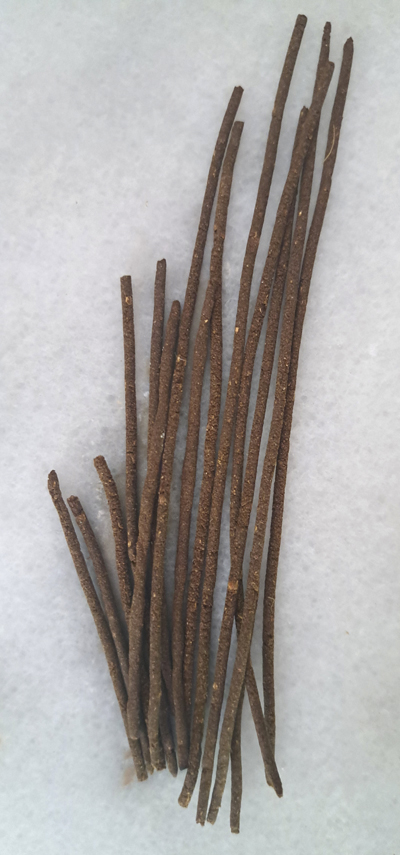Simple Incense Sticks With Cassia Cinnamon and Frankincense
It all started with an obscure incense cone recipe on the internet that someone posted at r/Incense seeking help because they tried it, and it didn’t work. It apparently contained no binder, just spices, including cinnamon. A few months later, I got into a conversation with Stephen Hoffman (ORS; also on Reddit) and he told me about Tibetan incense sticks that are 100% cinnamon, wondering how that could be possible.
Because I like to brew coffee with spices, including cassia cinnamon, I remembered how slimy the coffee grounds get when filtering, and that gave me an idea.
Could cassia cinnamon be a binder?
I mixed cassia powder and some water in a small bowl, stirred it occasionally, and the mixture did indeed get thicker over the course of 2–4 hours, until it formed a sticky mass that was able to cling to a spoon without dripping. I spontaneously grabbed some ground frankincense (which I usually use for “tea”) and a finely ground gingerbread spice mix, and made a dough with the cassia slime, which I could actually roll into sticks and a cone. After drying, they were stable and burned nicely, though unfortunately, they didn’t smell particularly good.
But I was hooked. I had always thought that making incense sticks was incredibly tedious and complicated – could it really be this simple?
To have a better basis for further experiments, I repeated the process, this time weighing and noting everything. I used a bit more frankincense and added a small amount of activated charcoal, as I suddenly doubted whether they would still burn with more frankincense.
Ingredients:
- 2g cassia cinnamon powder
- 20ml water
- 8.5g gingerbread spice (cinnamon [presumably Ceylon], anise, cloves, ginger, and coriander seeds)
- 4g frankincense (Boswellia papyrifera)
- 0.2g activated charcoal (scraped from a tablet)

Again, I soaked the cinnamon first and then added the dry ingredients.
The scent of this batch was better. Spicy, but still quite smoky. The aroma has improved with storage, though. I think it’s mainly a matter of taste. People who like rustic scents will find this recipe better than I did.
In the meantime, I also repeated the experiment with Ceylon cinnamon, which didn’t work (see image: comparison of Ceylon and cassia).
Based on this recipe, I experimented further with different types of frankincense and developed the following recipes:
Frankincense & Cassia
I soak 1g of cassia and add the remaining 3g with the other ingredients later into the dough. The cassia powder should not be soaked with the full amount of water, as the required amount can vary.
It should be possible to mix all the ingredients together and then gradually add water, but it is essential to let the dough rest for several hours to activate the mucilage in the cassia bark.
The dough has the right consistency when it doesn’t break or crack when folded.
It should feel a bit sticky to the hands or tools, but not leave any residues. If it feels slimy, it contains much water.
| Ingredients | Amount |
|---|---|
| Cassia powder (Cinnamomum cassia) | 4g |
| Distilled water | 10ml |
| Frankincense, e.g., B. sacra; B. dalzielii; B. papyrifera | 4g |
| Myrrh (Commiphora myrrha) | 0.4g |
| Tolu balsam (hard) | 0.3g |
| Activated charcoal | 0.4g |
| Total | 9.1g |
If you want to vary the recipe, make sure to choose a Boswellia resin that contains a gum content. You can easily recognize this by checking whether the resin completely melts when heated on charcoal or a burner, or if part of it remains. Resins without gum content will melt entirely.
Tolu balsam can also be replaced with benzoin resin. If you prefer not to add extra sweetness, you can leave it out and use more myrrh instead. The opposite is also possible.
If you want to skip both, you can reduce the charcoal content.
If you use pre-ground activated charcoal, you should sift it again, as it often contains larger granules that can cause issues during extrusion.
Dry the sticks for 2–3 days, or a bit longer if you live in a very humid climate. After that, they should be allowed to mature for at least 2 weeks.
You will be surprised at how little of the cassia base you can smell. The scent profile is strongly influenced by the resinous fragrance of the frankincense, and the individual character of the Boswellia species used will become more pronounced the longer you allow them to mature.
Indian Frankincense & Cardamom
Easy Variant
(The sophisticated version can be found here.)

As above, I soak part of the cinnamon with a portion of the water and let it swell, then add the remaining ingredients. The dough has the right consistency when it does not break or crack when folded.
I use whole cardamom pods, which I grind including the shell in my electric coffee grinder. Grinding the loose seeds results in a much coarser texture. Additionally, the spice is so potent that using the shells does not affect anything.
As mentioned above, charcoal bought as powder should be sieved again.
| Ingredients | Amount |
|---|---|
| Cassia powder (Cinnamomum cassia) | 4.5g |
| Distilled water | 10ml |
| Indian frankincense (Boswellia serrata) | 5g |
| Cardamom | 1g |
| Siam Benzoin (Styrax tonkinensis) | 0.4g |
| Activated charcoal | 0.5g |
| Total | 11.4g |
Activated charcoal content: 4.4%.
In both cases, I extrude the sticks to a thickness of about 1.5mm. This is roughly the same thickness as most Japanese incense sticks.
During drying, the sticks shrink slightly, primarily in length. For the last batch of B. serrata & Cardamom, I measured: Wet, they were 15-17cm long, and after drying, they only measured 13-15cm.
As well, in this recipe, the cinnamon completely fades into the background. The spice that you can smell is indeed the cardamom, which is less than a quarter of the cassia content.
I chose B. serrata for this recipe because, of the types I’ve used for making incense sticks so far, it has pleased me the most, despite being one of the frankincense types I generally like the least.
Serrata seems particularly well-suited for incense sticks. Its scent is somewhat spicier than others, and what I perceive as “oily” in its profile when heated on a stove makes the incense stick’s scent softer. Nonetheless, these are very strong, resinous, and spicy-smelling incense sticks.
For more details on the required tools and materials, please refer to my post:
If you use this recipe for inspiration, I would be delighted to receive feedback with criticism and your experiences.
Sources of Supply:
- I buy my ground cassia from Gewürzmanufaktur Zimtstangl & Muskatblüte a very charming family business. I also purchase cardamom pods (and all our kitchen spices) from there.
- Hard Tolu balsam is rather difficult to come by, but Jeomra has it in stock, as does SonnLicht.de – although theirs turned out to be not fully hard.
- Both shops are also good sources for Frankincense; another noteworthy one is kirchen-weihrauch.de.
Jeomra has the widest selection, but beware: many of the rarer Boswellia varieties such as B. neglecta, B. rivae, B. frereana, and the varieties from Socotra do not contain any gum, and I’m not sure if the cassia recipe would work with these. - The activated charcoal I use is of cosmetic quality and is made from coconut shells. I don’t have a specific source for it. It’s also possible to use other types of charcoal, but please ensure not to use “self-igniting” or “easy-lighting” incense charcoal or hookah charcoal tabs, as these contain potassium nitrate (better known as saltpetre), the smell of which you may be familiar with from sparklers.


